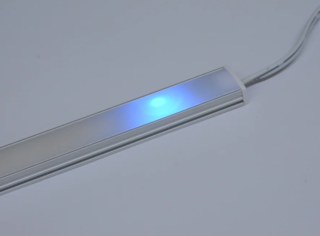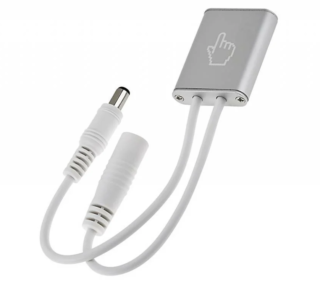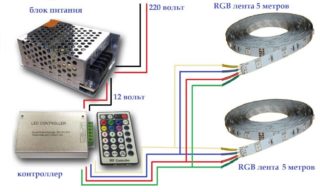LED strips are used over kitchen and work surfaces to provide functional lighting. They do an excellent job with an accent role in niches, headboards, behind curtain slats, floristic corners, for lighting floors, stairs. Due to the low heating capacity of LEDs (only 4% of power consumption for heating and 96% for lighting), they are mounted in a kitchen set, shelves of shelves, drawers. 12 V power supply allows equipping car interiors with them. Remote control RGB tapes are widely used in festive illumination, landscape and architectural lighting, and advertising window dressing.
Types of switches with a sensing element

LED backlighting differs from other lamps in low power consumption (up to 24 V), so the rows of diodes are connected to the mains through a power supply. The choice of the latter should be carried out with a power reserve of 15–20%. The switch is in between.
Ribbons with single one-color crystals are bypassed with a regular button. RBG controllers are used with colored LED rows. The touch switch for LED strip does not involve mechanical force to close the circuit and has a number of advantages:
- contactless actuation avoids contamination with grease in the kitchen, engine oil in the garage, paints and other things in the workshop;
- prevents moisture from entering the mechanism;
- in medical institutions, it reduces the doctor's contact with potentially contaminated surfaces;
- equipped with additional functionality;
- the appearance is laconic, they are placed in an aluminum profile together with an array of diodes.
Touch switches for LED strips are boards that fit into the LED profile (average dimensions 40 * 10 * 2 mm), external modules in a plastic case or controllers with a remote control. Depending on the length and power of the tape, models of the corresponding characteristics are selected:
- incoming and outgoing voltage;
- standby and load current;
- power.

For monochrome LED strips, 2 types of breakers are used, different in principle of operation. In capacitive devices, the spring fits snugly against the plate and provokes vibration from touch, creates contact and turns on the light. If the diffuser is made of plexiglass with a thickness of more than 1 mm, the mechanism will not work. The infrared receiver reacts to the reflection of the signal from the object in the range of the optical sensor (up to 100 mm). If the distance between the sensing element and the protective screen is more than 5 mm, a hole in the diffusing lens or a shallower profile is required.
Touch dimmers dim the lighting from 10% to 100%. A short touch (approaching a hand) turns on and off the lighting, and a long touch changes the brightness. The principle of operation may be different: each interaction switches a pre-programmed lighting scenario. The RBG strip control panel (LEDs of 3 crystals of different colors) is supplemented with a sensor ring. The device is simple and straightforward. As you move your finger along the spectral circle, the shade of the glow changes. In this case, the adaptation mechanism uses diodes of a certain color separately or in combinations. The simultaneous operation of all crystals gives a cool white illumination.
When choosing a switch, you should not ignore the frequency of the PWM pulses.If the indicator does not reach 300 Hz, the eyesight and nervous system of the residents will suffer.
Additional functions:
- an adaptive indicator reacts to the level of illumination in the room, automates the operation of the lamp depending on the time of day, penetration of sunlight and the presence of other sources;
- protection against short circuits and polarity reversal;
- motion sensor (range 3-5 m, wrap angle ~ 100%);
- timer;
- “Accompanying light” - gradual fading in order not to get out of the room in the dark.
Device and connection of the switch to the LED profile
The Touch Communicator consists of the following elements:
- shell (for embedded views, its role is played by a diffusing screen);
- sensing element — spring, infrared sensor and receiver, motion sensor;
- switching circuit - signal-to-electrical converter.
LED strips and circuit breakers for them are designed for a voltage of 12-24 V, therefore they are connected to the network only through the power supply.
If the sensor is installed in a ready-made lamp, the cap and the diffuser are removed first. The tape is cut into 1-2 sections according to special markings to make room for the switch.
You will need special connectors or low power soldering irons (25, 40 W) to connect the wires. The standard cable cross-section is 1.5 mm2. For illumination longer than 5 m, the calculation is carried out individually.
First, the stripped and crimped wires of the wiring join the switch with the connector in front of the power supply, and then with the illuminator.
How to easily connect the selected touch switch to the LED strip, the markings will prompt:
- VCC, GND - plus and minus, which come from the power supply;
- LED +, LED- - go to diodes.
The adhesions are insulated with hot melt glue or heat shrink tubing. In the selected device, the work parts must occupy one side. If they are on different sides, the switch cannot be fixed in the profile. The location of the sensor is indicated by a blue LED. The tape, together with the switch, is fixed in the aluminum profile on double-sided tape, a protective panel is installed and fixed with a plug.
Some manufacturers of lighting devices produce illuminators that are equipped with a touch dimmer and a built-in power supply for connecting to a 220 V network.
Installation of RBG controllers and self-assembly of the touch communicator
Power enters the controller through V + and V- (COM). 1-2 strips of maximum length 5 m are connected in parallel without problems. If the required length of LED lighting is longer, an amplifier is used.
Controller Tools:
- buttons or touch panel directly on the device;
- control panel via infrared port (full signal passability is required);
- PU radio control;
- wireless sensor or mobile device app over Wi-Fi.
With sufficient knowledge and skills in the field of electrical engineering, you can try to assemble the touch switch yourself. In the simplest circuit, the receiver is a copper or aluminum element soldered to a 0.22 μF capacitor. Two KT315 transistors are connected in series to it, and then a 30 Ohm resistor and a system of parallel connected 100 μF (16 V) electric capacitor, a 400 Ohm relay and a D226 semiconductor. There can be a third capacitor in parallel with the circuit.
The history of the "smart home" begins with the invention of dimmers. Now they are an integral part of it. Contactless communicators allow lighting fixtures to adapt to the habits and needs of a person, reducing the cost of time and energy resources.Touch-sensitive LED lighting for the kitchen, hallway and staircase contributes to a safer living.










